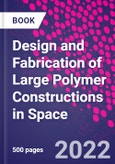Design and Fabrication of Large Polymer Constructions in Space is a ground-breaking study of the polymeric materials, advanced chemical processes, and cutting-edge technology required in the construction of large polymer-based structures for space, when all steps in the process are carried out in the space environment, whether in orbit, in deep space, or on the surface of a moon, asteroid, or planet.The book begins by introducing the fundamentals and requirements of large constructions and inflatable structures for space. The next section of the book focuses on the utilization of polymeric materials within the space environment, examining the effects on materials (vacuum, plasma, temperature), the possible approaches to polymerization both in space and in orbit, the preparation and structure of polymer composites, and the methods for testing materials and structures in terms of strength, defects, and aging. Three chapters then cover how these materials and techniques might be applied to specific categories of construction, including larger space habitats, supporting space structures, and ground infrastructure. Finally, the financial aspects, the consequences for human space exploitation, and the possible future developments are discussed.Using materials science to push the boundaries of construction for space exploration and exploitation, this book is a unique resource for academic researchers and advanced students across polymer science, advanced materials, chemical engineering, construction, and space engineering, as well as for researchers, scientists and engineers at space agencies, companies and laboratories, involved in developing materials or technology for use in space. This is also of great interest to anyone interested in the role of materials science in the building of large space stations, spacecraft, planetary bases, large aperture antenna, radiation and thermal shields, and repairmen sets.
Please Note: This is an On Demand product, delivery may take up to 11 working days after payment has been received.
Table of Contents
1. Constructions in space2. Inflatable structures3. Materials in the space environment4. Chemical curing of composite materials on earth5. Chemical curing in a vacuum6. Chemical curing in plasma and ion beams7. Chemical curing in temperature variations8. Chemical curing in flights9. Composite wall structures10. Curing process in earth orbit11. Evaluation of construction 12. Large space habitat13. Supporting space structures14. Ground infrastructure15. Prospective finances and investment
Authors
Alexey Kondyurin Honorary Senior Researcher, School of Physics, University of Sydney, Australia. Dr. Kondyurin is Honorary Senior Researcher, at the School of Physics, University of Sydney, Australia. His previous posts include Professor at the Institute of Mechanics, Perm State University, Russia, and Researcher at the Helmholtz Rossendorf Nuclear Center, Dresden, Germany. Dr. Kondyurin has over 200 scientific publications to his name, including 6 published books, and holds 6 patents. He has extensive experience working on projects funded by governmental or industry bodies, receiving the Astronautic Association Award "Medal of Achievements in Astronautics' in 2008, and the Alexander von Humboldt Fellowship in 2001.Dr. Kondyurin is a Chartered Member of the Royal Australian Chemical Institute (RACI), a member of the American Chemical Society (ACS), and a member of the Society of Plastics Engineers (SPE). He has also been guest editor for the Advanced Space Research Journal, and editor of a special issue 'Energetic Materials and Processes' for the Materials journal.
Dr. Kondyurin's main research interests are the design, synthesis and characterization of advanced polymer materials, spectroscopy usage and techniques, plasma and ion beam implantation methods, surface analysis, and mechanical analysis.








